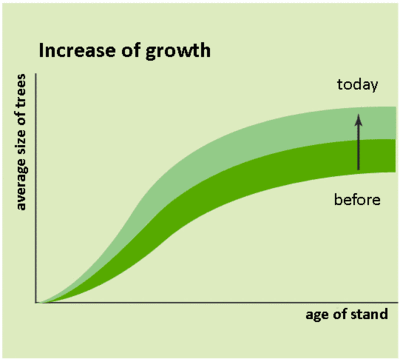For over a century now, forest ecosystems have increasingly been being affected by climate changes. A few decades ago, the phenomenon of "Waldsterben" (forest dieback) led us to doubt whether forest ecosystems could survive at all over large areas. Nowadays, however, terrestrial phenological investigations, satellite-based studies of photosynthetic activity and forest inventories would seem to indicate not the collapse of the forests, but accelerated growth. Whether, how and why forest stands have changed their growth patterns over the course of the last century is still the subject of heated debate.
Accelerated, but otherwise similar
It has also been the subject of research carried out by the Chair of Forest Growth and Yield at the Technical University of Munich (TUM). The data on which the research is based comes from long-term experimental forest plots that have been monitored systematically since 1870, making them some of the oldest test areas of their kind in the world. In the cases of spruce and beech, there has been significant acceleration since 1960
- in tree growth (+32 to +77 %),
- in stand volume growth (+10 to +30 %) and
- in standing stock accumulation (+6 to +7 %).
The forest stands continue to follow general allometric rules for trees and stands. The volume reached does not thus change at a given stand height, for example. The same tree and stand sizes are simply reached at an earlier age than was the case in the past. Because the trees and forest stands develop more quickly, the number of trees at a given age is currently between 17 and 20 % lower than it was in the past. Statistical analyses show that the acceleration in growth is primarily due to rises in temperature and extended growing seasons. This is particularly clear on sites with a plentiful supply of nutrients.
Effects
The accelerated growth and ageing of the trees and forests also lead to a need for adaptation: the accelerated growth may force plants and animals whose habitats are dependent on particular stages and structures in forest development to become more mobile in order to survive. The accelerated growth may benefit people through increased carbon sequestration, but also through benefits to the forestry industry. Target diameters and the optimum harvest rotation age are reached earlier than in the past. The forestry industry can respond to the increased level of growth by raising the annual cut.
Current growth trends permit higher standing stock densities at a given age than used to be the case, although this is also in fact a requirement if more wood is to be harvested. With conventional thinning concepts there is a risk of stand density being too low. This is associated with increment losses, because the raised, age-related capacity would not be fully exploited.
Because defined tree sizes, stand volume and mortality rates are achieved 20 to 30 years earlier, age-based experience values, yield tables and other values are rendered obsolete. Risky development stages are negotiated more quickly than in the past. Shortened rotation periods can reduce the risk of forest damage, caused for example by windthrow, bark beetle infestation or snow breakage.

